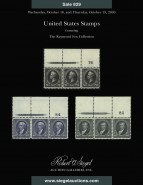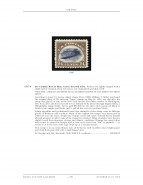⇚ Position 64 - 2000-10-18 Transaction Summary ⇛
Purchase Date:
2000-10-18
How Purchased:
Auction
Where Purchased:
Siegel Auction Galleries
Auction No.:
829-United States Stamps
Lot No.:
1086
Sound/Fault:
Sound
Catalogue Value:
$ 150,000
Realized:
$ 121,000
Seller:
Anonymous
Buyer:
Description
24c Carmine Rose & Blue, Center Inverted (C3a). Position 64, lightly hinged with a small narrow remnant, deep rich colors, one unpunched perf disk at left
VERY FINE. A BRIGHT AND FRESH WELL-CENTERED EXAMPLE OF THE FAMOUS INVERTED JENNY.
According to Jenny! by George Amick (Amos Press, 1986), William T. Robey purchased the original sheet of 100 inverted "Jenny" stamps on May 14, 1918, one day after the stamp was placed on sale, at the New York Avenue Post Office window in Washington, D.C. Soon after, the sheet was sold to Col. Edward H. R. Green through Eugene Klein, a Philadelphia stamp dealer. Green paid $20,000 for the sheet, then instructed Klein to divide it into singles and blocks, and to sell all but a few key position blocks.
Stamp specialists and professionals know that examples of this stamp come in different grades of freshness and condition. Many of the original 100 stamps were mistreated by collectors over the years, despite the stamps' rarity and value. Colonel Green himself allowed moisture to affect some of the stamps he retained. Other examples have become slightly toned from improper storage and climatic conditions. Hinging has caused thins and creases in numerous stamps, and at least seven have been "lost" to philately -- or nearly so as in the case of the copy swept up in a vacuum cleaner.
This stamp is in an extraordinary state of freshness, with excellent color, bright paper and clean fresh gum with only a small hinged area.
Ex Haydon and Col. Aisenstadt. With 2000 P.F. certificate
VERY FINE. A BRIGHT AND FRESH WELL-CENTERED EXAMPLE OF THE FAMOUS INVERTED JENNY.
According to Jenny! by George Amick (Amos Press, 1986), William T. Robey purchased the original sheet of 100 inverted "Jenny" stamps on May 14, 1918, one day after the stamp was placed on sale, at the New York Avenue Post Office window in Washington, D.C. Soon after, the sheet was sold to Col. Edward H. R. Green through Eugene Klein, a Philadelphia stamp dealer. Green paid $20,000 for the sheet, then instructed Klein to divide it into singles and blocks, and to sell all but a few key position blocks.
Stamp specialists and professionals know that examples of this stamp come in different grades of freshness and condition. Many of the original 100 stamps were mistreated by collectors over the years, despite the stamps' rarity and value. Colonel Green himself allowed moisture to affect some of the stamps he retained. Other examples have become slightly toned from improper storage and climatic conditions. Hinging has caused thins and creases in numerous stamps, and at least seven have been "lost" to philately -- or nearly so as in the case of the copy swept up in a vacuum cleaner.
This stamp is in an extraordinary state of freshness, with excellent color, bright paper and clean fresh gum with only a small hinged area.
Ex Haydon and Col. Aisenstadt. With 2000 P.F. certificate


